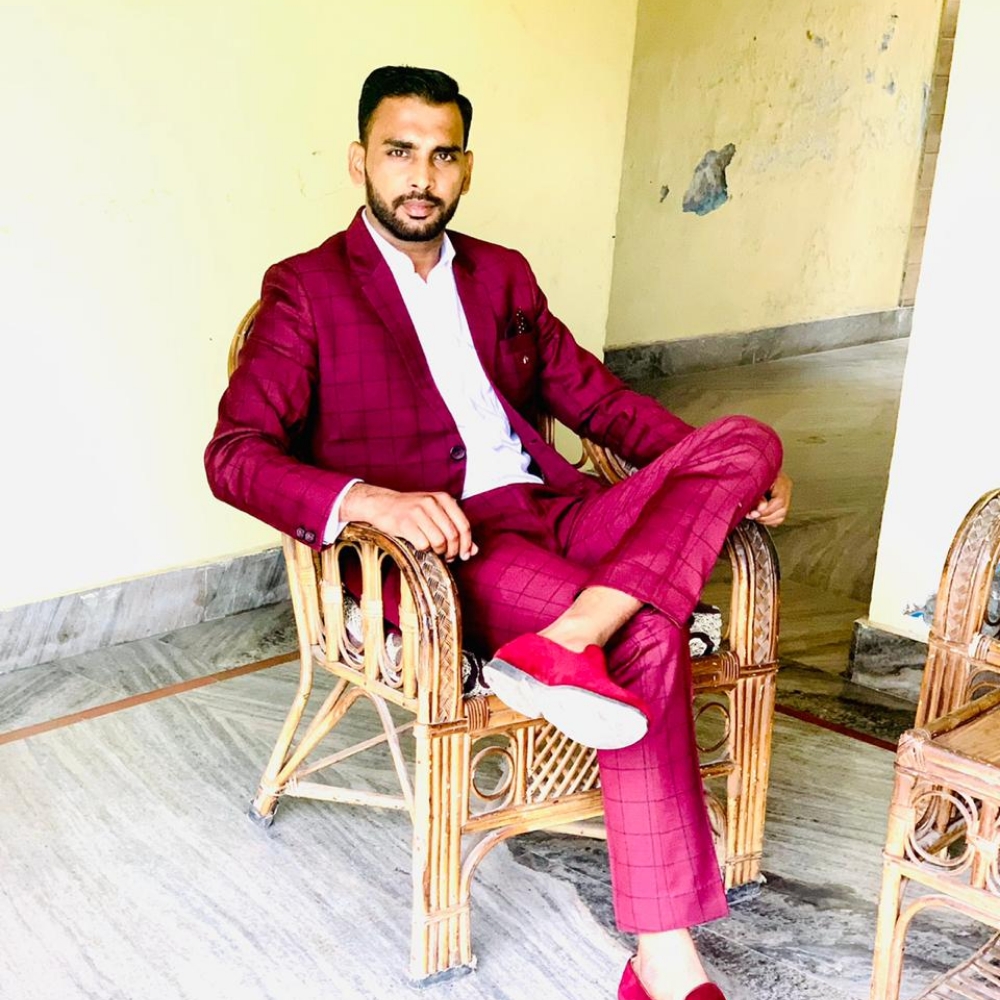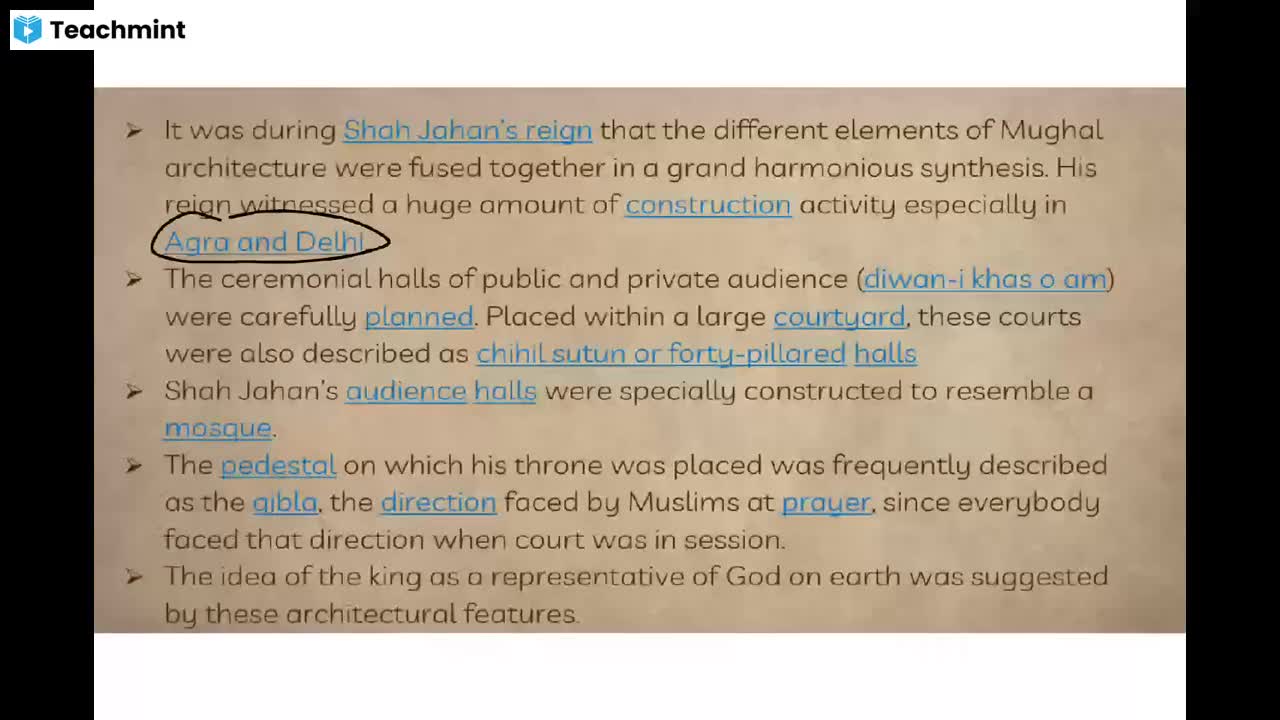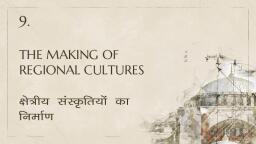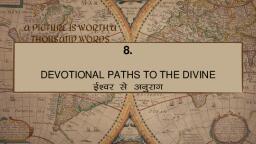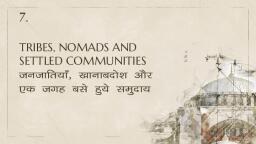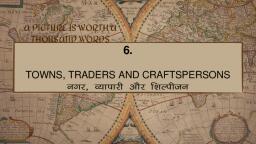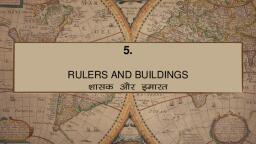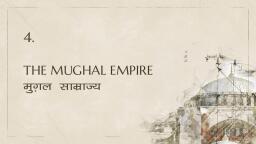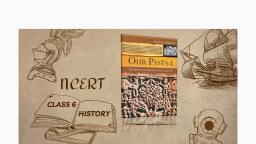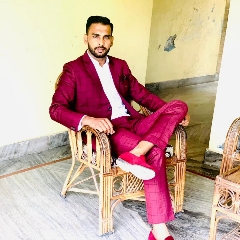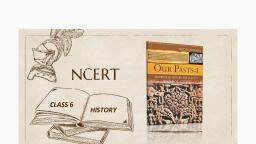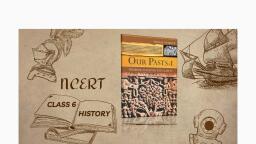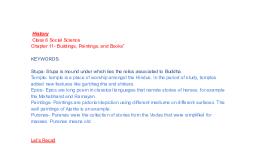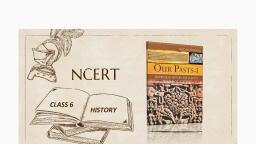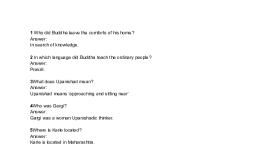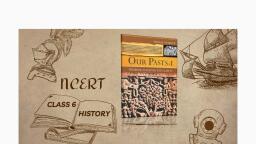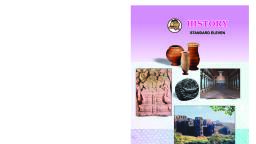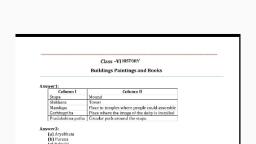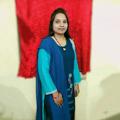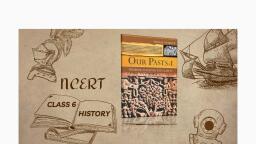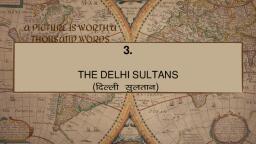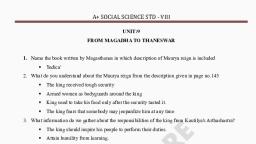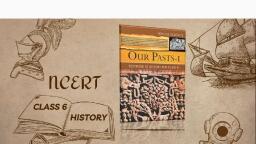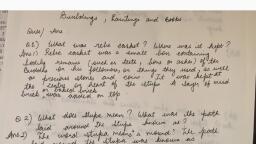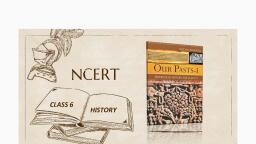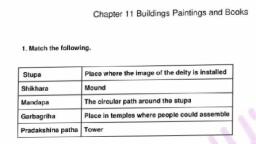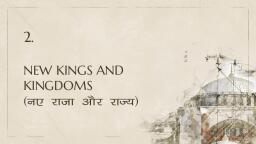Page 3 :
OVERVIEW, 1., 2., 3., 4., 5., 6., 7., 8., 9., 10., 11., 4, , METALLURGY, THE IRON PILLAR, BUILDINGS IN BRICK AND STONE, STUPA, MONOLITHIC TEMPLES AT MAHABALIPURAM, HOW WERE STUPAS AND TEMPLES BUILT?, PAINTING, THE WORLD OF BOOKS, RECORDING AND PRESERVING OLD STORIES, STORIES TOLD BY ORDINARY PEOPLE, WRITING BOOKS ON SCIENCE
Page 4 :
Metallurgy ( /krq foKku), ⬗ Archaeological excavations have shown that the Harappans were, master craftsmen and had knowledge of copper metallurgy., ⬗ They even manufactured bronze by mixing copper and tin., ⬗ While the Harappans belonged to the Bronze Age, their successors, belonged to the Iron Age. India produced highly advanced types, of iron-forged iron, wrought iron and cast iron., 5
Page 5 :
The iron pillar ( ykSg LraH) ), ⬗ The iron pillar at Mehrauli, Delhi, is a remarkable, example of the skill of Indian crafts persons., , ⬗ It is made of iron, 7.2. m high, and weighs over 3, tonnes. It was made about 1500 years ago., , ⬗ We know the date because there is an inscription, on the pillar mentioning a ruler named Chandra,, who probably belonged to the Gupta dynasty., , 6
Page 6 :
Buildings in brick and stone (bUVksa vkSj iRFkjksa dh bekjrs), ⬗ The skills of our crafts persons are also apparent in the buildings that have, survived, such as stupas., ⬗ The word stupa means a mound. While there are several kinds of stupas, round, and tall, big and small, these have certain common features., ⬗ Generally, there is a small box placed at the centre or heart of the stupa. This, may contain bodily remains (such as teeth, bone or ashes) of the Buddha or his, followers, or things they used, as well as precious stones, and coins., ⬗ This box, known as a relic casket, was covered with earth. Later, a layer of mud, brick or baked brick was added on top. And then, the dome like structure was, sometimes covered with carved stone slabs., , 7
Page 7 :
⬗ The Great Stupa at Sanchi, Madhya Pradesh., Stupas like this one were built over several, centuries. While the brick mound probably, dates to the time of Ashoka, the railings and, gateways were added during the time of later, rulers., , 8
Page 8 :
⬗ Often, a path, known as the pradakshina patha,, was laid around the stupa. This was, surrounded with railings. Entrance to the path, was through gateways. Devotees walked, around the stupa, in a clockwise direction, as a, mark of devotion. Both railings and gateways, were often decorated with sculpture., , ⬗ Amaravati, This was a place where, a magnificent stupa, once existed ., 9
Page 9 :
⬗ Many of the stone carvings for decorating the stupa were made about, 2000 years ago., ⬗ Other buildings were hollowed out of rock to make artificial caves., Some of these were very elaborately decorated with sculptures and, painted walls., ⬗ Some of the earliest Hindu temples were also built at this time. Deities, such as Vishnu, Shiva, and Durga were worshipped in these shrines., ⬗ The most important part of the temple was the room known as the, garbhagriha, where the image of the chief deity was placed. It was here, that priests performed religious rituals, and devotees offered worship to, the deity., 10
Page 10 :
BHITARGAON, An early temple at, Bhitargaon, Uttar, Pradesh,was built, about 1500 years, ago, and was made, of baked brick and, stone., , 11
Page 11 :
Monolithic temples at Mahabalipuram., ⬗ Each of these was carved out of a huge, single, piece of stone (that is why they are known as, monoliths ( ,dk'e)). While brick structures, are built up by adding layers of bricks from the, bottom upwards, in this case the stone cutters, had to work from, top, downwards., , 12
Page 12 :
THE DURGA TEMPLE AT AIHOLE, ⬗ Built about 1400 years ago., , 13
Page 13 :
Often, as at Bhitargaon, a tower, known as the shikhara, was built on top of, the garbhagriha, to mark this out as a sacred place., Building shikharas required careful planning. Most temples also had a space, known as the mandapa. It was a hall, where people could assemble., , 14
Page 14 :
How were stupas and temples built?, First, good quality stone had to be found, quarried, and, , transported to the place that was often carefully chosen for, the new building., These rough blocks of stone had to be shaped and carved, , into pillars, and panels for walls, floors and ceilings. And then, these had to be placed in precisely the right position., 15
Page 15 :
⬗ Kings and queens probably spent money from their treasury to pay the, crafts persons who worked to build these splendid structures., , ⬗ Besides, when devotees came to visit the temple or the stupa, they often, brought gifts, which were used to decorate the buildings, , ⬗ Among the others who paid for decorations were merchants, farmers,, garland makers,perfumers, smiths, and hundreds of men and women who, are known only by their names which were inscribed on pillars, railings, and walls., , 16
Page 16 :
Jaina monastery from Orissa, This two storey building was carved out of the rock, surface., Notice the entrance to the rooms. Jaina monks lived, and meditated in these rooms., , 17
Page 17 :
A sculpture from the National Museum,, New Delhi, , 18
Page 18 :
Painting (fp=dyk), Ajanta is a place where several caves were, hollowed out of the hills over centuries. Most, of these were monasteries for Buddhist monks,, and some of them were decorated with, paintings., As the caves are dark inside, most of these, paintings were done in the light of torches. The, colours, which are vivid even after 1500 years,, were made of plants and minerals. The artists, who created these splendid works of art remain, unknown, 19
Page 20 :
The world of books, Epics are grand, long compositions, about heroic men and women, and include, stories about gods., A famous Tamil epic, the Silappadikaram, was composed by a poet named Ilango,, around 1800 years ago., It is the story of a merchant named Kovalan, who lived in Puhar and fell in love with a, courtesan named Madhavi, neglecting his wife Kannagi. Later, he and Kannagi left, Puhar and went to Madurai, where he was wrongly accused of theft by the court, jeweller of the Pandya king. The king sentenced Kovalan to death. Kannagi, who still, loved him, was full of grief and anger at this injustice, and destroyed the entire city of, Madurai., 21
Page 21 :
The world of books, Another Tamil epic, the Manimekalai, Composed by Sattanar around 1400 years ago., This describes the story of the daughter of Kovalan and Madhavi. These beautiful, compositions were lost to scholars for many centuries, till their manuscripts were, rediscovered, about a hundred years ago., , Other writers, such as Kalidasa, wrote in Sanskrit., , 22
Page 22 :
A verse ('yksd) from the Meghaduta, Here is a verse from Kalidasa’s best-known poem, the Meghaduta, in which a, monsoon cloud is imagined to be a messenger between lovers who are separated from, one another., See how the poet describes the breeze that will carry the cloud northwards :, “A cool breeze, delightful as it is touched, With the fragrance of the earth Swollen by your showers,, Inhaled deeply by elephants,, And causing the wild figs to ripen,, Will blow gently as you go.”, 23
Page 23 :
Recording and preserving old stories, iqjkuh dgkfu;ksa dk ladyu rFkk laj{k.k, A number of Hindu religious stories that were in circulation earlier were written, down around the same time. These include the Puranas., Purana literally mean old., The Puranas contain stories about gods and goddesses, such as Vishnu, Shiva,, Durga or Parvati. They also contain details on how they were to be worshipped., Besides, there are accounts about the creation of the world, and about kings., , The Puranas were written in simple Sanskrit verse, and were meant to be heard by, everybody, including women and shudras, who were not allowed to study the Vedas., They were probably recited in temples by priests, and people came to listen to, them., 24
Page 24 :
Two Sanskrit epics, the Mahabharata and Ramayana had been popular for a very, long time., , The Mahabharata is about a war fought between the Kauravas and Pandavas, who, were cousins., , This was a war to gain control of the throne of the Kurus, and their capital,, Hastinapura. The story itself was an old one, but was written down in the form in, which we know it today, about 1500 years ago., Both the Puranas and the Mahabharata are supposed to have been compiled by, Vyasa. The Bhagavad Gita, was also included in the Mahabharata., , 25
Page 25 :
RAMAYANA, The Ramayana is about Rama, a prince of Kosala, who was sent into exile., His wife Sita was abducted by the king of Lanka, named Ravana, and Rama, had to fight a battle to get her back. He won and returned to Ayodhya, the capital, of Kosala, after his victory., Like the Mahabharata, this was an old story that was now written down., Valmiki is recognised as the author of the Sanskrit Ramayana, , 26
Page 26 :
Stories told by ordinary people, Ordinary people also told stories, composed poems and songs, sang, danced, and, performed plays., Some of these are preserved in collections of stories such as the Jatakas and the, Panchatantra, which were written down around this time., Stories from the Jatakas were often shown on the railings of stupas and in, paintings in places such as Ajanta., , 27
Page 27 :
The story of the monkey king, Once upon a time there was a great monkey king, who lived on the banks of the, Ganga in the Himalayas, with 80,000 followers. They fed on the fruit of a special, mango tree………………….. the king discovered that the monkeys were also, feasting on the fruit, and decided to kill them., The king of the monkeys worked out a plan to save his followers. He broke off, branches of the mango tree, and tied them to form a ‘bridge’ across the river, and, held on to one end till all his followers crossed over. Exhausted with the effort, he, fell down and lay dying., The human king saw what had happened, and tried unsuccessfully to revive the, monkey. When he died, the king mourned his death and paid him full respect., 28
Page 28 :
Story is shown on a piece of sculpture found from, a stupa at Bharhut in central India., , 29
Page 29 :
Writing books on science (foKku), This was also the time when Aryabhata, a mathematician and astronomer, wrote, a book in Sanskrit known as the Aryabhatiyam., He stated that day and night were caused by the rotation of the earth on its axis,, even though it seems as if the sun is rising and setting everyday., He developed a scientific explanation for eclipses as well., He also found a way of calculating the circumference of a circle, which is nearly, as accurate as the formula we use today., , VARAHAMIHIRA, BRAHMAGUPTA and BHASKARACHARYA were, some other mathematicians and astronomers who made several discoveries., 30
Page 30 :
Zero, While numerals had been used earlier, mathematicians in India, now invented a special symbol for zero., This system of counting was adapted by the Arabs and then spread, to Europe. It continues to be in use throughout the world., The Romans used a system of counting without using zero., , 31
Page 31 :
Ayurveda, Ayurveda is a well-known system of health science that was, developed in ancient India., The two famous practitioners of Ayurveda in ancient India were, Charaka (1st-2nd centuries C.E.) and Sushruta (c. 4th century C.E.), Charak Samhita, written by Charak is a remarkable book on, medicine., In his treatise, Susruta Samhita, Sushruta speaks about elaborate, surgical procedures., 32
Page 32 :
PAPER, Paper was invented in China about 1900 years ago, by a man named Cai Lun., He beat plant fibres, cloth, rope and the bark of trees, soaked these in water, and, then pressed, drained and dried the pulp to create paper., Even today, hand made paper is made through a similar process., , The technique of making paper was a closely guarded secret for centuries. It, reached Korea about 1400 years ago, and spread to Japan soon after., It was known in Baghdad about 1800 years ago., From Baghdad it spread to Europe, Africa, and other parts of Asia including the, subcontinent, 33
Page 34 :
Thanks!, , 35
